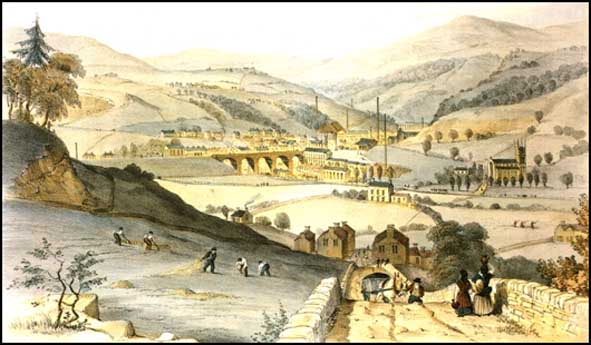ABOUT THE FIELDEN TRAIL
Sometime in the middle of the 16th century one William Fielden, yeoman farmer, married and set up house at Inchfield, a remote farmstead in the Walsden Valley, deep in the Pennines. From such humble beginnings sprang a family who were to play a major role in the social and economic development of the Upper Calder Valley; whilst one of their number, 'Honest John' Fielden, was destined to make his name in parliament as a champion of the labouring classes, thus entering the name of Fielden into the annals of the nation's history.
In this book you will walk through town and countryside, through urban bustle and through wild and lonely places where the wind howls through shattered walls and tumbled stones. You will discover the Fieldens: who they were, where they lived and how they lived. You will also see how Todmorden grew from a small hamlet to an industrial mill town; you will see the coming of the mills, the canals, the railways, riots and revelations, rough-hewn hillfolk seeking salvation, and the right to vote. You will see how the Fieldens and the story of Todmorden are inseperable, nothing of any note ever happened in Todmorden without there being a Fielden around to witness it. In finding the Fieldens you will also discover the history of Todmorden.
Like Phyllis Bentley's Inheritance, The Fielden Trail traces the rise of a family of 'mill magnates', but with a difference, the people and places presented in this book are real! Todmorden and its surrounding districts was (and still is) 'home' to the Fieldens, who, unlike most textile barons, preferred to live near their workers and built their great houses nearby, rather than moving away to more genteel parts. Because of this, we are given the rare opportunity of being able to trace back their story through generation after generation without moving from the Todmorden area. In a day's ramble we can stroll through time and space, saunter through the centuries and visualise the whole panoply of Upper Calderdale's history through the eyes of one family, the Fieldens, who, even if they did not entirely bring about the development of Todmorden into a modern community certainly bore witness to all of it.
The Fielden Trail is a thematic history trail. It is not, however, a journey that involves an afternoon's gentle stroll around the 'sights' of Todmorden. On the contrary, it is a tough hike of some 19 miles or more involving a lot of repeated ascent and as much descent. Section 1 to Cornholme and Sections 2 and 3 to Dawson Weir and Rake End follow the upland shelf for much of the way, but Section 4 takes to the high moors, following a route which involves some rough going along the high moorland ridge between Gaddings and Stoodley Pike, not a journey to be undertaken badly equipped in inclement weather (which is the norm rather than the exception at Stoodley Pike). I have divided the walk into sections intentionally, the end of each section providing an easy escape route back to the centre of Todmorden. Thus it is possible to walk the Fielden Trail in sections as a leisurely ramble, or in its entirety as a tough challenge walk. In the early days of planning the Fielden Trail, I had great doubts about the possibility of such a route. It seemed that merely connecting locations with Fielden associations would not give me a walk that made any geographical (or historical) sense; but yet, as I researched my subject more deeply, I found that pieces of a puzzle have a habit of falling into place exactly where you want them to fall.
The geography of the Fielden Trail is fascinating. Unlike many walks, you finish up almost where you started, so this is a walk for motorists. Todmorden lies at the confluence of two rivers and three valleys: the Fielden Trail follows the edges of all three valleys, creating a walk that constantly winds back upon itself, as if one were walking around 'The Legs of Man'. By the time you have walked the Fielden Trail you will know the topography of the Todmorden area quite intimately, having viewed Todmorden from virtually every point of the compass. Even if you aren't the slightest bit interested in the Fieldens and find history boring (like my wife) you'll find it's still worth doing just for the walk. Study or challenge, history or hike, you will find the Fielden Trail physically and mentally stimulating, walking through hill and dale, town and countryside, past and present.
The Fielden Trail is an arduous walk of almost 20 miles. Those undertaking it as a 'challenge walk' are strongly advised to prepare well. Stout boots, food and waterproofs are necessary, particularly on the upland sections.
Follow the Country Code. Do not leave litter, climb walls or disturb livestock. Leave gates as you find them, beware of fires and keep dogs under control.
The maps in this book should be used in conjunction with a suitable Ordnance Survey map, eg the South Pennines 1:25000.


Copyright Jim Jarratt.
2006 First Published by Smith Settle 1989
In this book you will walk through town and countryside, through urban bustle and through wild and lonely places where the wind howls through shattered walls and tumbled stones. You will discover the Fieldens: who they were, where they lived and how they lived. You will also see how Todmorden grew from a small hamlet to an industrial mill town; you will see the coming of the mills, the canals, the railways, riots and revelations, rough-hewn hillfolk seeking salvation, and the right to vote. You will see how the Fieldens and the story of Todmorden are inseperable, nothing of any note ever happened in Todmorden without there being a Fielden around to witness it. In finding the Fieldens you will also discover the history of Todmorden.
Like Phyllis Bentley's Inheritance, The Fielden Trail traces the rise of a family of 'mill magnates', but with a difference, the people and places presented in this book are real! Todmorden and its surrounding districts was (and still is) 'home' to the Fieldens, who, unlike most textile barons, preferred to live near their workers and built their great houses nearby, rather than moving away to more genteel parts. Because of this, we are given the rare opportunity of being able to trace back their story through generation after generation without moving from the Todmorden area. In a day's ramble we can stroll through time and space, saunter through the centuries and visualise the whole panoply of Upper Calderdale's history through the eyes of one family, the Fieldens, who, even if they did not entirely bring about the development of Todmorden into a modern community certainly bore witness to all of it.
The Fielden Trail is a thematic history trail. It is not, however, a journey that involves an afternoon's gentle stroll around the 'sights' of Todmorden. On the contrary, it is a tough hike of some 19 miles or more involving a lot of repeated ascent and as much descent. Section 1 to Cornholme and Sections 2 and 3 to Dawson Weir and Rake End follow the upland shelf for much of the way, but Section 4 takes to the high moors, following a route which involves some rough going along the high moorland ridge between Gaddings and Stoodley Pike, not a journey to be undertaken badly equipped in inclement weather (which is the norm rather than the exception at Stoodley Pike). I have divided the walk into sections intentionally, the end of each section providing an easy escape route back to the centre of Todmorden. Thus it is possible to walk the Fielden Trail in sections as a leisurely ramble, or in its entirety as a tough challenge walk. In the early days of planning the Fielden Trail, I had great doubts about the possibility of such a route. It seemed that merely connecting locations with Fielden associations would not give me a walk that made any geographical (or historical) sense; but yet, as I researched my subject more deeply, I found that pieces of a puzzle have a habit of falling into place exactly where you want them to fall.
The geography of the Fielden Trail is fascinating. Unlike many walks, you finish up almost where you started, so this is a walk for motorists. Todmorden lies at the confluence of two rivers and three valleys: the Fielden Trail follows the edges of all three valleys, creating a walk that constantly winds back upon itself, as if one were walking around 'The Legs of Man'. By the time you have walked the Fielden Trail you will know the topography of the Todmorden area quite intimately, having viewed Todmorden from virtually every point of the compass. Even if you aren't the slightest bit interested in the Fieldens and find history boring (like my wife) you'll find it's still worth doing just for the walk. Study or challenge, history or hike, you will find the Fielden Trail physically and mentally stimulating, walking through hill and dale, town and countryside, past and present. The Fielden Trail is an arduous walk of almost 20 miles. Those undertaking it as a 'challenge walk' are strongly advised to prepare well. Stout boots, food and waterproofs are necessary, particularly on the upland sections. Follow the Country Code. Do not leave litter, climb walls or disturb livestock. Leave gates as you find them, beware of fires and keep dogs under control. The maps in this book should be used in conjunction with a suitable Ordnance Survey map, eg the South Pennines 1:25000.
